
by Michael Barera
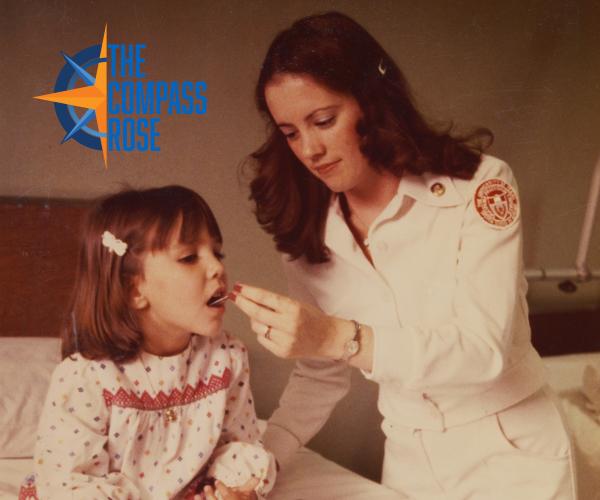

by Michael Barera
The purpose of The Compass Rose is to raise awareness of Special Collections' resources and to foster the use of these resources. The blog series also reports significant new programs, initiatives, and acquisitions of Special Collections.
This Compass Rose blog post provides an introduction and an overview to the new spring 2022 exhibit in Special Collections: A Tribute to Nurses: UTA and Beyond. This blog post is adapted from the text used in the exhibit and features photos that are displayed in the exhibit. That text was written and those photos were selected by Michael Barera, Laura Haygood, and Rae Jeffers.
The College of Nursing and Health Innovation (CONHI) at the University of Texas at Arlington (UTA) traces its roots back to the John Sealy Hospital Training School for Nurses in Galveston, which was established in 1890 and later became the University of Texas System School of Nursing. In 1972, a previously existing nursing program in Fort Worth became affiliated with the UT System, which ultimately moved to UTA in 1977 to become what is now CONHI.
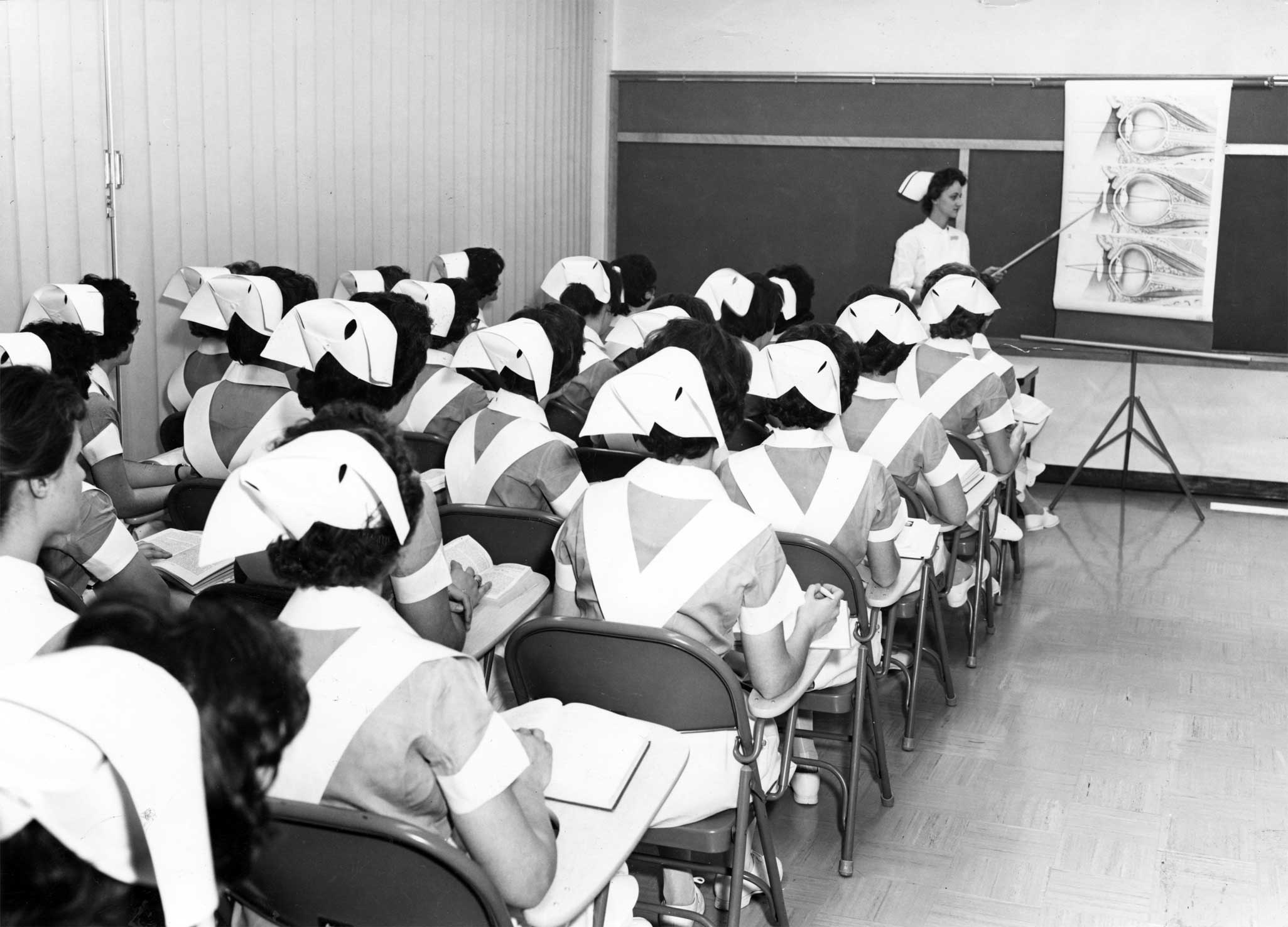
JPS Hospital instructor Carol Sturdivant teaching the anatomy of the eye to a class of nursing students. Circa 1961. (University of Texas at Arlington. School of Nursing Records, 2010-10)

Dr. Myrna Pickard examining a model of a pelvis with her students. Undated. (University of Texas at Arlington. College of Nursing Records, 2012-93)
This exhibit covers the history of nursing at UTA and beyond, focusing on major themes such as developments in the nursing profession; the training of nurses; public service during wartime; and rites of passage such as graduation, capping, and pinning ceremonies.
A Tribute to Nurses: UTA and Beyond is organized roughly chronologically, although some galleries are placed thematically or organized around the available physical space. The exhibit begins with a case on John Sealy Hospital, which was established in Galveston in 1890 as the first formal school of nursing in Texas and is the program to which the present UTA College of Nursing and Health Innovation (CONHI) traces its roots.
Near this case are exhibits on pinning, capping, and nursing uniforms. Nurses’ caps emerged in the 1800s as part of a global reform movement to transform the perception of nursing into a respected profession. As a rite of passage, it marked changes in social and occupational roles, as well as met educational milestones in nursing educational programs.
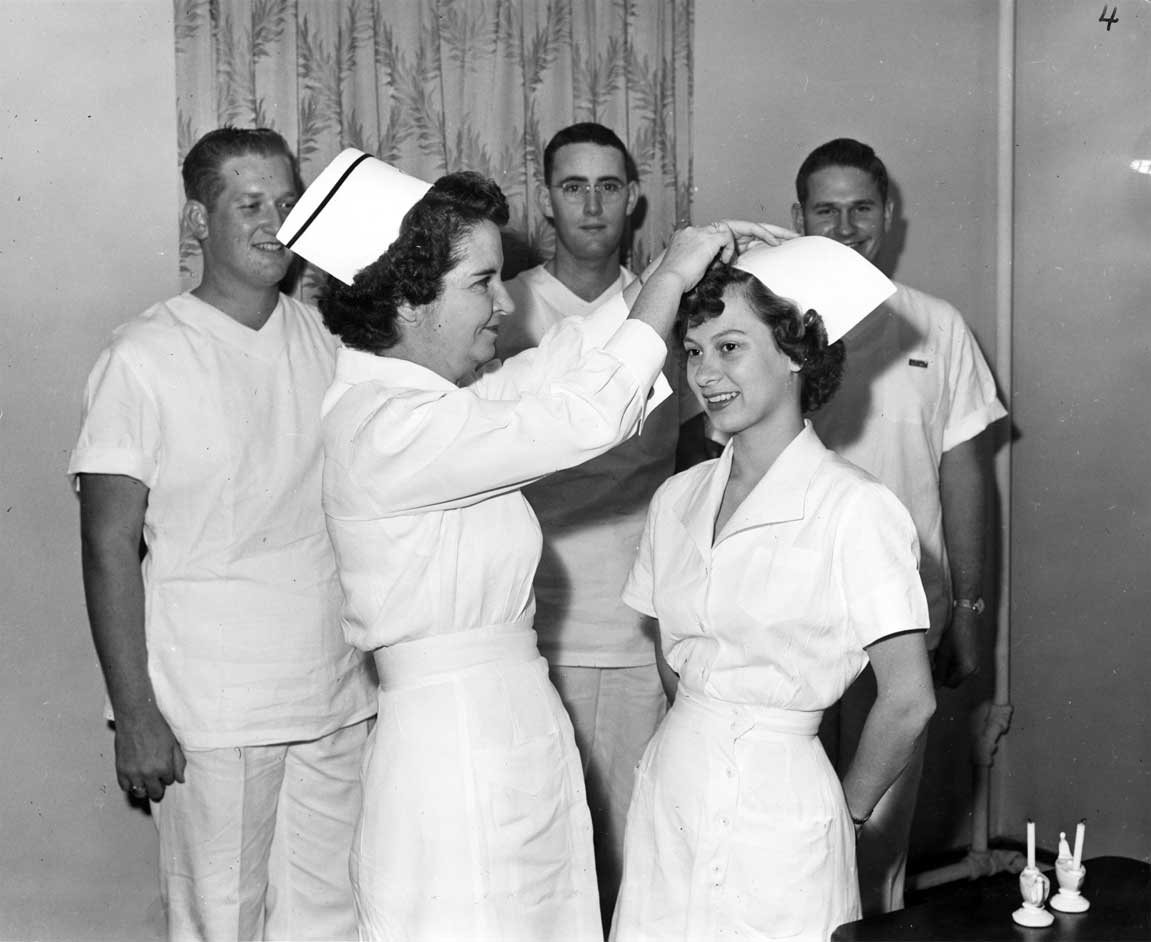
Capping ceremony for the class of 1955. Note that the male students do not have caps. Instead, they received epaulets on the shoulders of their uniforms. 1955. (University of Texas at Arlington. School of Nursing Records, 2010-10)
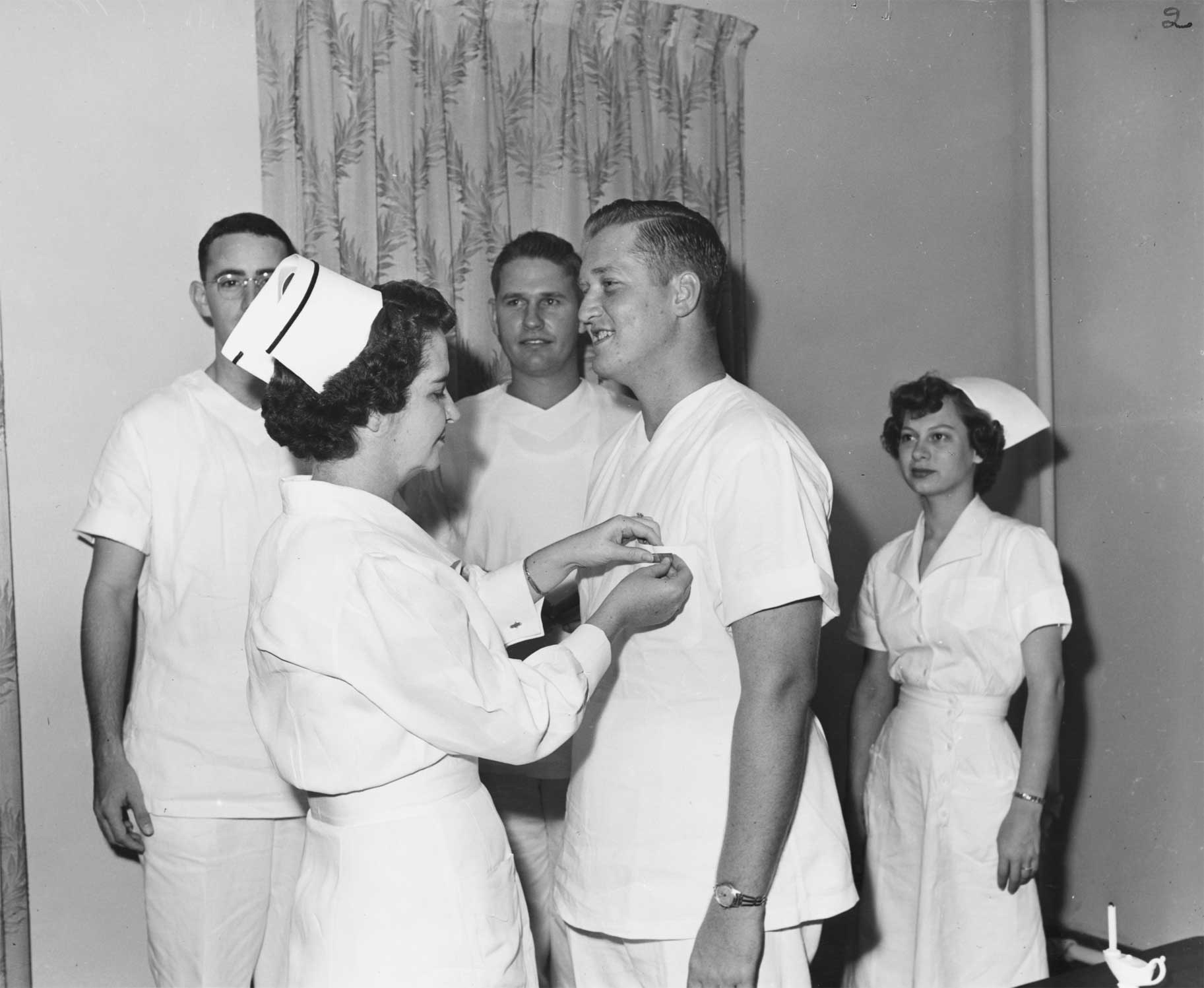
Male student receives a pin during the capping ceremony for the class of 1955. Note that caps were not part of the male nurse's uniform. 1955. (University of Texas at Arlington. School of Nursing Records, 2010-10)
The next exhibit chronologically features City-County Hospital, which opened in 1914 in Fort Worth. The hospital was renamed John Peter Smith (JPS) Hospital in 1954. John Peter Smith was a lawyer and realtor who was reputedly once the largest landowner in the city. Known as "the father of Fort Worth," he donated land for churches, cemeteries, parks, and hospitals, including what became JPS Hospital. Also featured are the United States Public Health Service (USPHS) and its service in both World Wars, largely comprised of posters from the era.

Nursing student holding a candle in front of a stained-glass window. The location is likely the JPS Hospital Chapel in Fort Worth. Undated. (University of Texas at Arlington. School of Nursing Records, 2010-10)
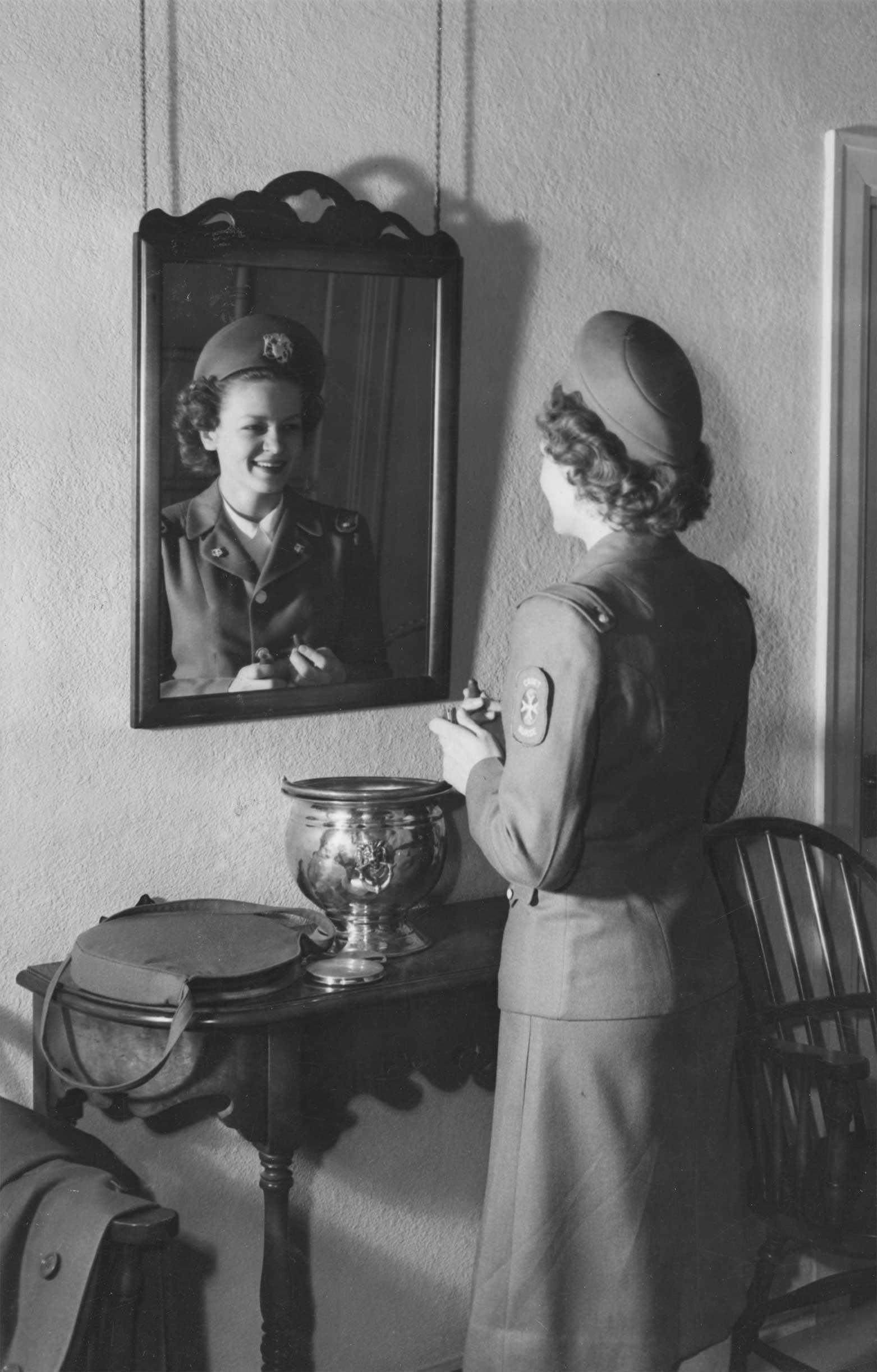
Cadet nurse in the U.S. Cadet Nurse Corps, which was supervised by the U.S. Public Health Service. The Cadet Nurse Corps operated between 1943 and 1948. Undated. (University of Texas at Arlington. School of Nursing Records, 2010-10)
In spring 1967, the UT System Coordinating Board recommended abolishing the School of Nursing administration in Galveston and replacing it with a unified central administration in Austin, arguing that this change and additional funding would eliminate the critical shortage of hospital nurses in the state. In 1972, the UT nursing schools and the central administrative office were collectively named the University of Texas System School of Nursing (UTSSN). The UTSSN established a regional school in Fort Worth in 1971, opening to students in 1972. In March 1976, the Board of Regents voted 7 to 2 to abolish the administration of the UTSSN, despite substantial opposition. This action placed each of the six UT System nursing schools under the system-affiliated university geographically closest to it by September 1, 1976.
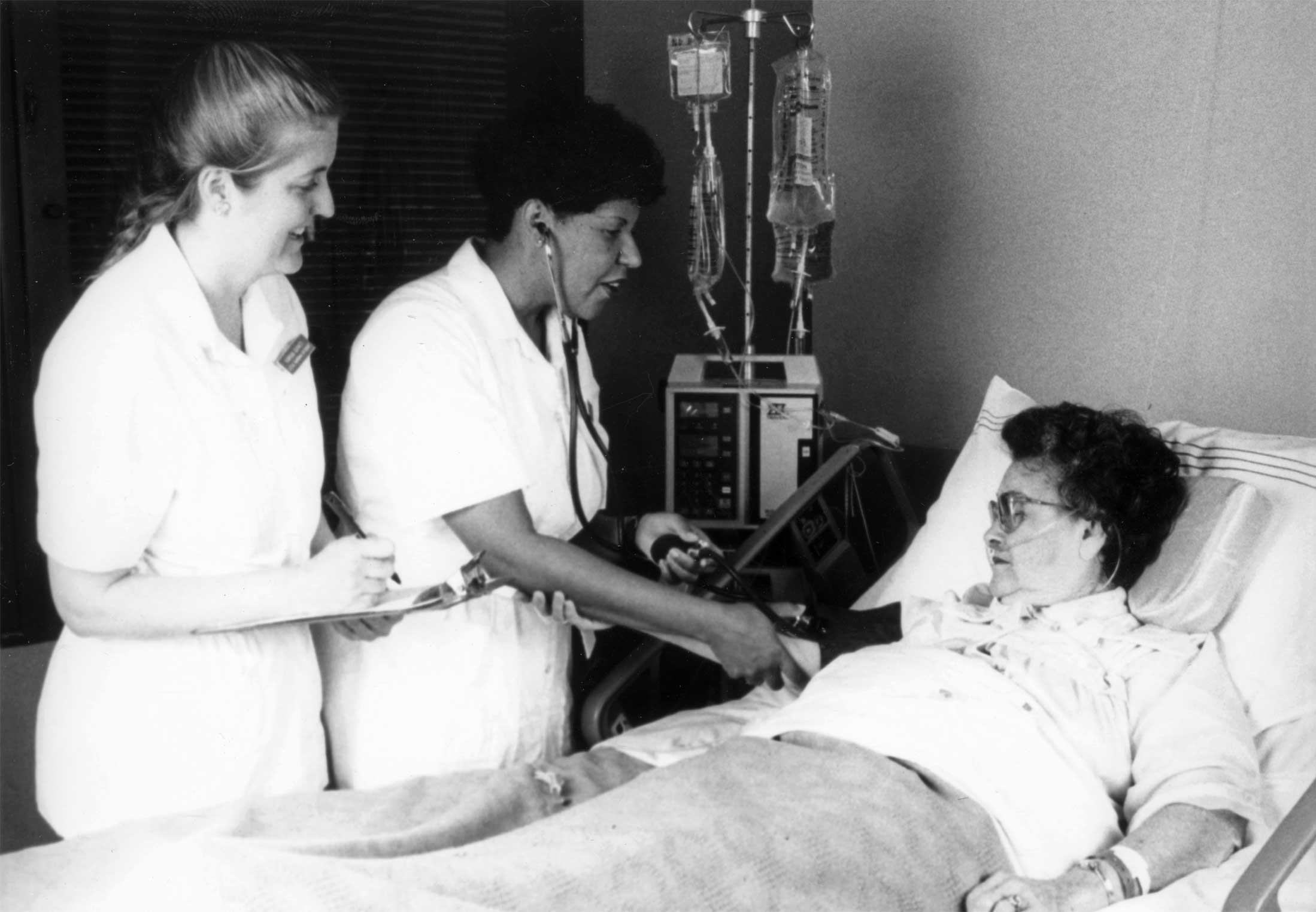
A UTA nursing student taking the blood pressure of a patient while another student records the measurements. Undated. (University of Texas at Arlington. College of Nursing Records, 2012-93)
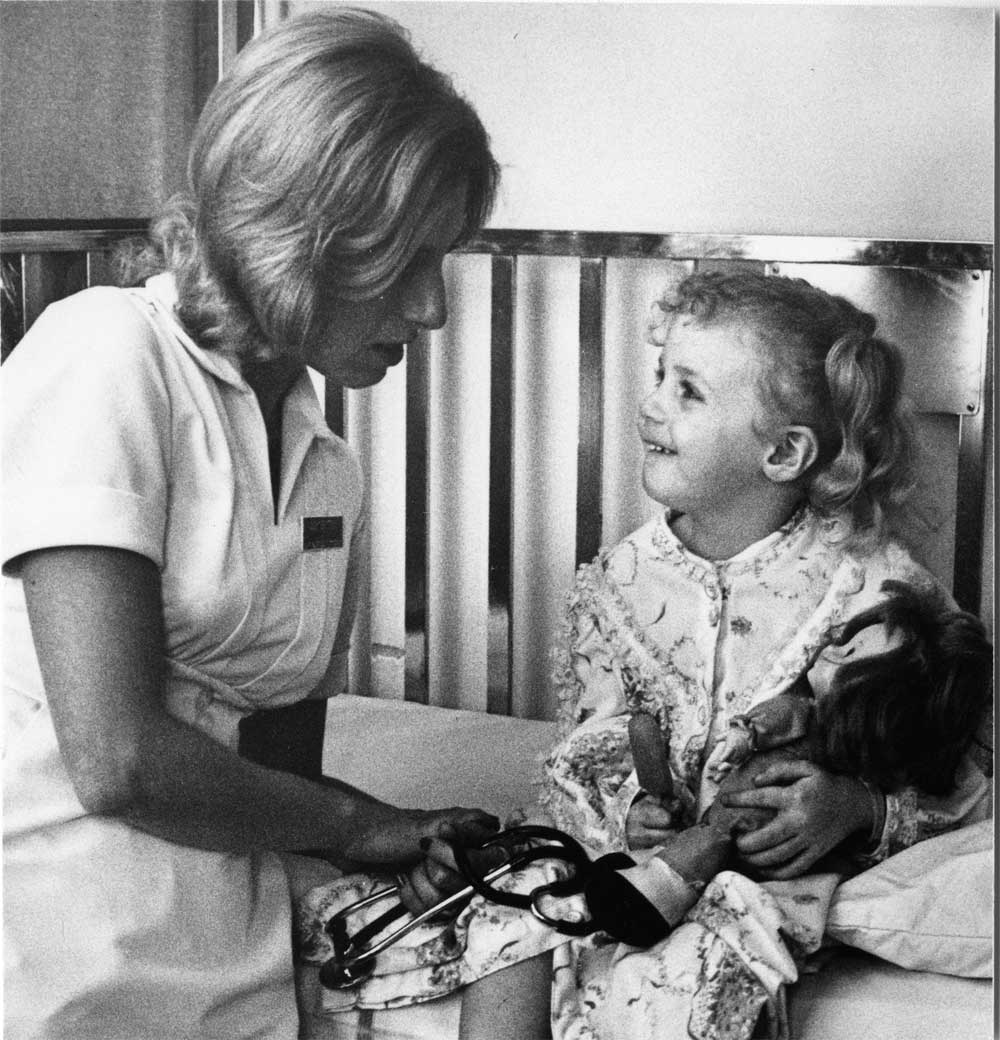
A UTA nursing student tends to a pediatric patient holding a doll. Undated. (From the collections of the UTA College of Nursing and Health Innovation)
In May 1976, the UT System Board of Regents refused to reconsider its reorganization of the system’s nursing program. In March 1976, Dean of the School of Nursing Dorothy Damewood wrote a memo to all faculty, staff, and students reading, "Although there are many who believe the System concept is the most effective way to facilitate nursing education in the UT System, we must recognize and respect the Board of Regents’ right and authority to make this decision." The UTSSN's Fort Worth program became affiliated with UTA and physically moved to Arlington in 1977.
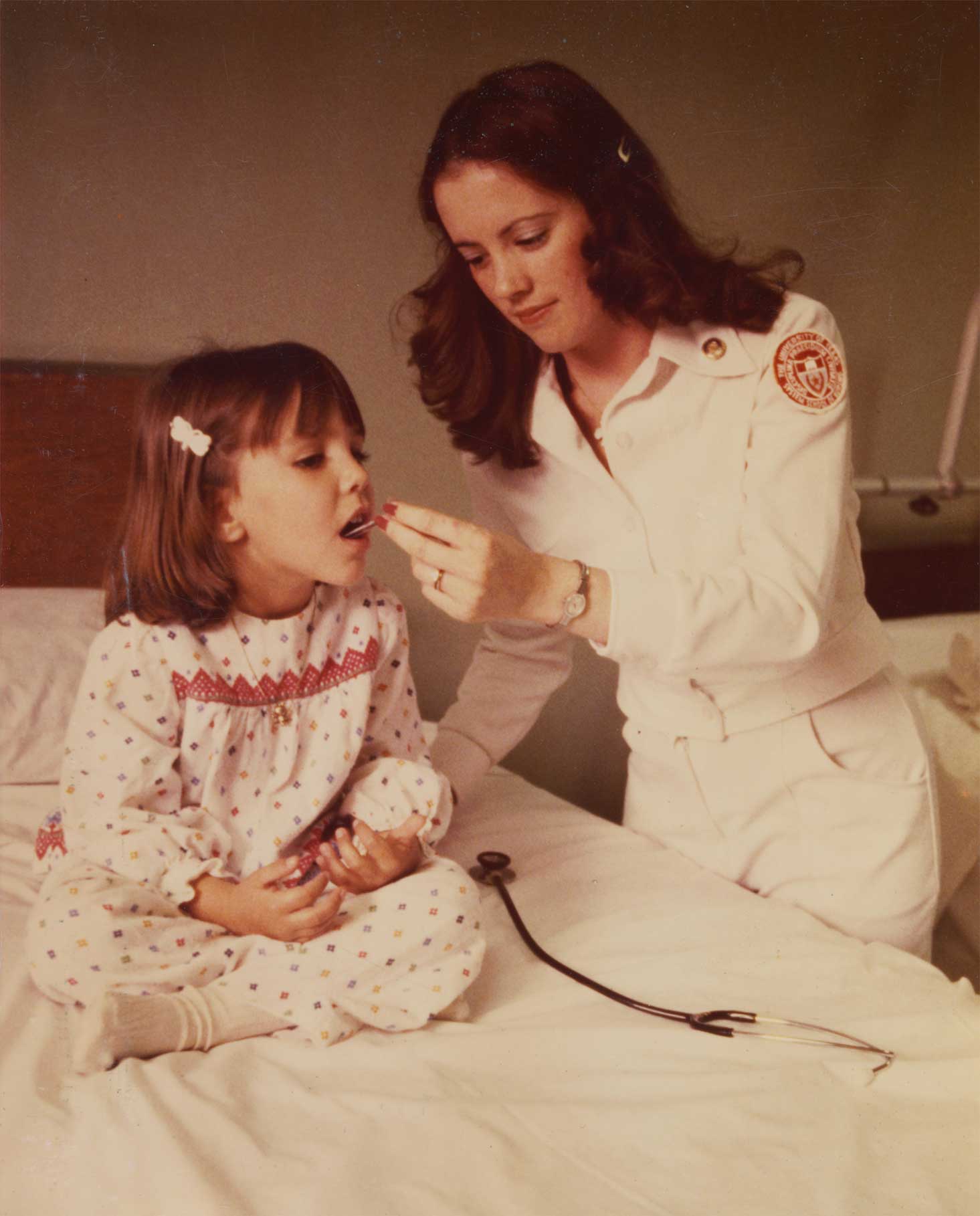
A UTSSN student checks the temperature of her pediatric patient. The UTSSN patch dates this photograph to no later than 1976. (University of Texas at Arlington. College of Nursing Records, 2012-93)
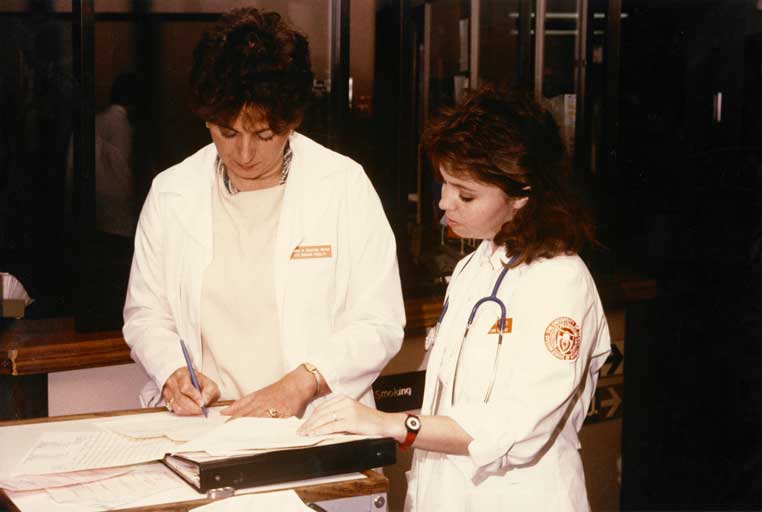
UTA nursing student with Dr. Hegstad, UTA nursing faculty. Undated. (From the collections of the UTA College of Nursing and Health Innovation)
After this reorganization, what is now the College of Nursing and Health Innovation (CONHI) has grown dramatically. Its distance education offerings have grown from a small satellite program to the largest non-profit nursing school in the country. Included in the UTA section of the exhibit are highlights of simulation, teaching and learning, and graduation.
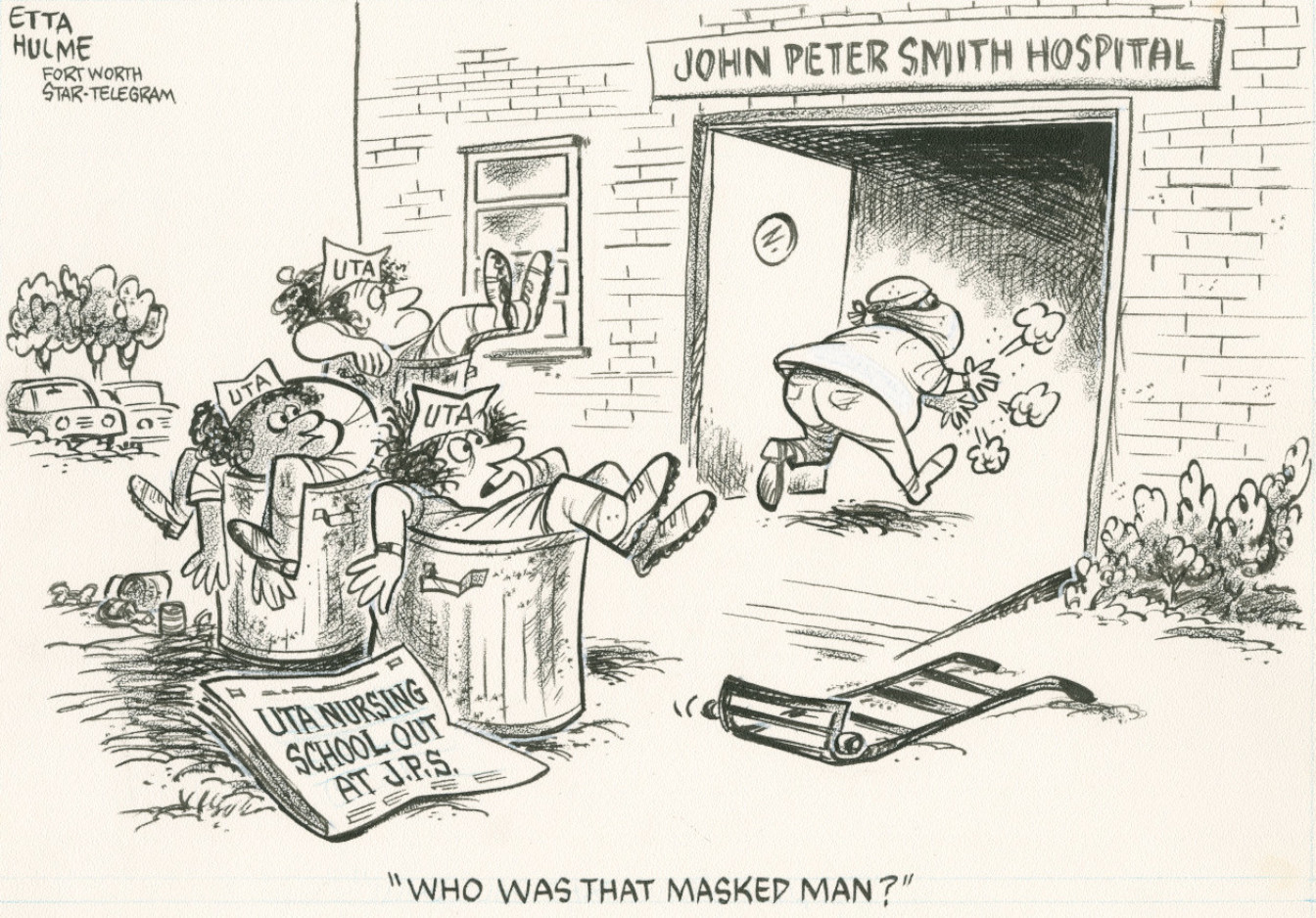
Etta Hulme Fort Worth Star-Telegram cartoon depicting the eviction of the UTA School of Nursing by JPS Hospital in Fort Worth for additional space for their family practice program. April 28, 1977. (Etta Hulme Papers, AR717)
In 1990, the UTA School of Nursing received an $800,000 grant from the United States Department of Health and Human Services to fund distance education. This funding established the Nursing Education Telecommunication Satellite System (NETSS), which broadcast live instruction to students in Texarkana and Waco. One year later, NETSS expanded to include sites in Paris and the Sherman-Denison metropolitan area.

Mary Lou Bond (left) and Myrna Pickard (right) at the UTA School of Nursing's NETSS. Undated. (From the collections of the UTA College of Nursing and Health Innovation)
Pickard Hall, originally known as the Nursing-Math Building, opened in 1982 as the new home of the School of Nursing. Designed with wide entries and windowed walls, the triangular building boasted state-of-the-art features such as television monitors in lecture classrooms, two-way mirrors for interviews and observations, and a first-floor Nursing Learning Resource Center that served as a simulation hospital. In 1995, it was renamed Pickard Hall in honor of Myrna Pickard, upon her retirement as the founding dean of the UTA School of Nursing. Both Pickard Hall and Myrna Pickard are documented in dedicated galleries.

The completed Nursing-Math Building (now Pickard Hall). Circa 1982. (From the collections of the UTA College of Nursing and Health Innovation)
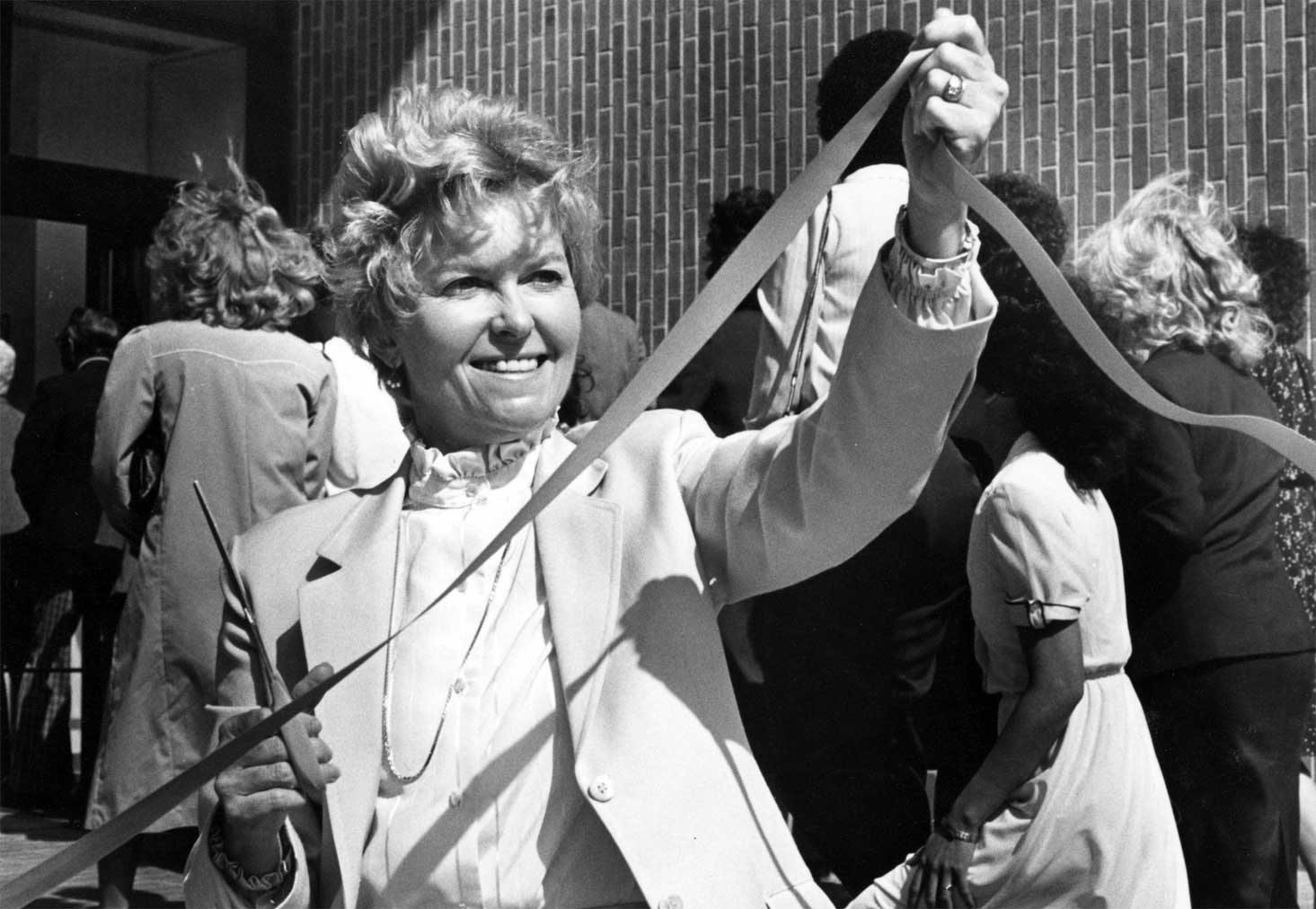
Dean Myrna Pickard during the ribbon-cutting ceremony at the newly constructed Nursing-Math Building, now renamed Pickard Hall in her honor. 1982. (From the collections of the UTA College of Nursing and Health Innovation)
The Smart Hospital is a 13,000-square-foot simulation hospital located on the UTA campus. It utilizes 60 patient simulators to provide students with hands-on skills in patient care. While simulation technology was already being used at UTA in a Phase 1 project, a 2005 grant of $496,000 was used to expand the Smart Emergency Department into the Smart Hospital.
There are dedicated galleries for the "wall of caring" as well as for male nurses. In addition to the photographs and documents featured in the galleries of this exhibit, there are also numerous medical artifacts (including medicines, equipment, books, and posters) that were generously loaned by UTA nursing faculty member Christine Roberts.
If you are interested in viewing A Tribute to Nurses: UTA and Beyond in person, it goes on display in the Special Collections department on the sixth floor of UTA's Central Library next week. The department is open to the public Tuesdays through Saturdays, from 9 am to 5 pm. An opening reception that is open to the public will be held in Special Collections on Thursday, March 3, from 6 to 8 pm.
Add new comment